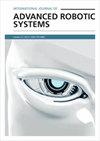A mutual positioning relay method of multiple robots for monitoring indoor environments
IF 2.1
4区 计算机科学
Q2 Computer Science
International Journal of Advanced Robotic Systems
Pub Date : 2022-09-01
DOI:10.1177/17298806221129842
引用次数: 1
Abstract
This article proposes a mutual positioning relay method that enables multiple robots to monitor indoor environments. Here, robots refer to a small number of parent robots with high positioning performance and a large number of child robots with minimal positioning performance. The parent robot can estimate its state accurately by itself. In comparison, the child robots have position errors that accumulate with time as they use only odometry information for positioning. Each robot can recognize other robots in its field of view by using a depth camera. It then performs relative positioning and estimates its position of itself or that of other robots on the map. The uncertainty of the position estimation is compared with each other, and the robot with a certain position becomes a positioning reference for the robot with an uncertain position. In this way, both the parent and child robots relay relative positioning with each other, following which all the robots accurately estimate their positions. In this study, six robots based on Roomba were used. The performance of the proposed method was verified based on experimental data of autonomous navigation tests. Our results showed that the proposed method could realize an accuracy that was four to five times better than that performed independently by a child robot. Our findings also revealed that the proposed method can recover the failure of the state estimation of the parent robot.一种用于室内环境监测的多机器人相互定位中继方法
本文提出了一种相互定位中继方法,使多个机器人能够监测室内环境。在这里,机器人是指少数具有高定位性能的父机器人和大量具有最低定位性能的子机器人。父机器人可以自己准确地估计其状态。相比之下,儿童机器人的位置误差会随着时间的推移而累积,因为它们只使用里程计信息进行定位。每个机器人都可以通过使用深度相机识别其视野中的其他机器人。然后,它进行相对定位,并估计自己或其他机器人在地图上的位置。将位置估计的不确定性相互比较,具有特定位置的机器人成为具有不确定位置的机器人的定位参考。通过这种方式,父机器人和子机器人相互传递相对定位,随后所有机器人都准确地估计自己的位置。在这项研究中,使用了六个基于Roomba的机器人。基于自主导航试验的实验数据验证了该方法的性能。我们的结果表明,所提出的方法可以实现比儿童机器人独立执行的精度高出四到五倍的精度。我们的研究结果还表明,所提出的方法可以恢复父机器人状态估计的失败。
本文章由计算机程序翻译,如有差异,请以英文原文为准。
求助全文
约1分钟内获得全文
求助全文
来源期刊
CiteScore
6.50
自引率
0.00%
发文量
65
审稿时长
6 months
期刊介绍:
International Journal of Advanced Robotic Systems (IJARS) is a JCR ranked, peer-reviewed open access journal covering the full spectrum of robotics research. The journal is addressed to both practicing professionals and researchers in the field of robotics and its specialty areas. IJARS features fourteen topic areas each headed by a Topic Editor-in-Chief, integrating all aspects of research in robotics under the journal''s domain.

 求助内容:
求助内容: 应助结果提醒方式:
应助结果提醒方式:


